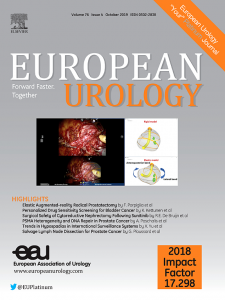Best Systemic Therapy With or Without Radical Prostatectomy in the Management of Men With Oligometastatic Prostate Cancer: The RAMPP Randomised Controlled Trial
IF 25.2
1区 医学
Q1 UROLOGY & NEPHROLOGY
引用次数: 0
Abstract
Background and objective
Our aim was to evaluate the effect of addition of radical prostatectomy (RP) to best systemic therapy (BST) on cancer-specific mortality (CSM) in patients with oligometastatic prostate cancer (omPC).Methods
This randomised controlled trial included patients with omPC with a low metastatic burden (1–5 bone metastases with/without nodal involvement) on conventional or PET imaging. Patients were randomised to receive either RP with pelvic lymph-node dissection plus BST (RP + BST) or BST alone. The primary endpoint was CSM. Secondary endpoints included clinical progression and overall survival (OS). Study accrual was stopped early because of a change in medical practice. Statistical analyses included cumulative incidence plots, Gray’s test, competing-risks regression, Kaplan-Meier estimates, and log-rank tests.Key findings and limitations
Between May 2015 and December 2018, 132 patients were randomised. The median age was 67 yr (interquartile range 63–71) and median prostate-specific antigen was 20 ng/ml (interquartile range 10–39). The 5-yr CSM cumulative incidence was 13% for RP + BST and 23% for BST alone (p = 0.037), with a hazard ratio of 0.39 (95% confidence interval 0.16–0.98; p = 0.045). The 5-yr cumulative incidence of clinical progression including CSM was 59% for RP + BST and 60% for BST alone. The 5-yr OS rate was 81% for RP + BST and 74% for BST alone. Clavien-Dindo grade ≥III surgery-related complications occurred in nine of 66 (14%) patients in the RP + BST arm. Limitations include early discontinuation of study accrual and the lack of statistical significance for the OS benefit.Conclusions and clinical implications
While this trial has substantial limitations, the results support addition of RP as local therapy to BST in omPC.This trial is registered on ClinicalTrials.gov as NCT02454543.
有或没有根治性前列腺切除术的男性少转移性前列腺癌的最佳全身治疗:RAMPP随机对照试验
背景与目的我们的目的是评估在最佳全身治疗(BST)的基础上加行根治性前列腺切除术(RP)对少转移性前列腺癌(omPC)患者癌症特异性死亡率(CSM)的影响。方法:该随机对照试验纳入常规或PET成像的低转移负担(1-5例骨转移伴/不伴淋巴结累及)的omPC患者。患者被随机分配接受RP合并盆腔淋巴结清扫加BST (RP + BST)或单独BST。主要终点为CSM。次要终点包括临床进展和总生存期(OS)。由于医疗实践的改变,研究提前终止。统计分析包括累积发生率图、格雷检验、竞争风险回归、Kaplan-Meier估计和log-rank检验。在2015年5月至2018年12月期间,132名患者被随机分组。中位年龄为67岁(四分位数范围为63-71),中位前列腺特异性抗原为20 ng/ml(四分位数范围为10-39)。5年CSM累积发病率RP + BST为13%,单独BST为23% (p = 0.037),风险比为0.39(95%可信区间0.16-0.98;p = 0.045)。包括CSM在内的5年累积临床进展发生率,RP + BST组为59%,单独BST组为60%。RP + BST的5年生存率为81%,单独BST的5年生存率为74%。RP + BST组66例患者中有9例(14%)发生Clavien-Dindo级≥III级手术相关并发症。局限性包括早期终止研究累积和OS获益缺乏统计学意义。结论和临床意义虽然这项试验有很大的局限性,但结果支持在comppc中加入RP作为BST的局部治疗。该试验在ClinicalTrials.gov上注册为NCT02454543。
本文章由计算机程序翻译,如有差异,请以英文原文为准。
求助全文
约1分钟内获得全文
求助全文
来源期刊

European urology
医学-泌尿学与肾脏学
CiteScore
43.00
自引率
2.60%
发文量
1753
审稿时长
23 days
期刊介绍:
European Urology is a peer-reviewed journal that publishes original articles and reviews on a broad spectrum of urological issues. Covering topics such as oncology, impotence, infertility, pediatrics, lithiasis and endourology, the journal also highlights recent advances in techniques, instrumentation, surgery, and pediatric urology. This comprehensive approach provides readers with an in-depth guide to international developments in urology.
 求助内容:
求助内容: 应助结果提醒方式:
应助结果提醒方式:


